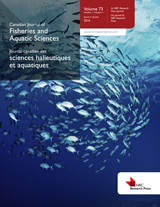Population genetic structure of the snow crab (Chionoecetes opilio) at the Northwest Atlantic scale
Abstract
Marine species with planktonic larval durations of several months (teleplanic larvae) can potentially maintain demographic connectivity across large geographical distances. This perspective has important fundamental and applied implications, notably for the understanding of evolutionary and ecological processes in the marine realm, the implementation of marine protected areas, and fisheries management. Here we present, at the scale of the Northwest Atlantic, a spatial analysis of snow crab (Chionoecetes opilio, Majoidea) population genetic structure, a species that has a planktonic larval phase of 3 to 5 months. Eight microsatellite markers analysed on 847 C. opilio samples from 13 locations revealed an absence of significant genetic structure along the west coast of Greenland and within Atlantic Canada from southern Labrador to Nova Scotia. These results are consistent with a scenario of extensive demographic connectivity among C. opilio populations and have implications for the management of this species, which supports one of the most important Canadian and Greenlandic fisheries in terms of economic value. A genetic break is nevertheless identified between Greenland and Atlantic Canada, showing that genetic structure can develop within seas (the Labrador Sea in this case) despite the occurrence of very long planktonic larval stages.

